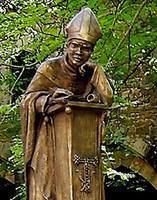Name Thietmar Merseburg | Parents Siegfried I von Walbeck Died December 1, 1018 | |
 | ||
People also search for Boleslaus I, Duke of Bohemia, Strachkvas, Adalbero of Wurzburg | ||
Grandparents Lothar II von Walbeck | ||
Thietmar (also Dietmar or Dithmar; 25 July 975 – 1 December 1018), Prince-Bishop of Merseburg from 1009 until his death, was an important chronicler recording the reigns of German kings and Holy Roman Emperors of the Ottonian (Saxon) dynasty. Two of Thietmar's great-grandfathers, both referred to Liuthar, were the Saxon nobles Lothar II, Count of Stade, and Lothar I, Count of Walbeck. They were both killed fighting the Slavs at the Battle of Lenzen.
Contents
Life
Thietmar was a son of the Saxon count Siegfried I the Older of Walbeck (d. 990) and his wife Kunigunde (d. 997), daughter of Henry I the Bald, Count of Stade (House of Udonids). His father fought with Margrave Odo against Duke Mieszko I of Poland at the 972 Battle of Cedynia. At the time of Thietmar's birth, his family sided with the Ottonian duke Henry II of Bavaria ("the Wrangler") in his uprising against his cousin Emperor Otto II. Later, a balance was achieved; Siegfried became burgrave at Möckern and his brother Count Lothair of Walbeck served as margrave of the Northern March from 983 until his death in 1003.
Baptized in Halberstadt, Thietmar prepared for an ecclesiastical career. He was educated at the St. Servatius chapter of Quedlinburg Abbey and from 987 onwards at the Benedictine abbey of Berge in Buckau near Magdeburg. From 1 November 990, he attended the Magedeburg cathedral school, together with his relative Bruno of Querfurt. He was familiar with the works of Augustine of Hippo, but even more with classical authors like Virgil, Horace, Lucan, and Macrobius.
Thietmar witnessed the struggles of the young Ottonian king Otto III and his mother Theophanu to secure their reign. He took some part in some political events of the time; in 994 he was a hostage in the hands of the Northmen, and he was not unfamiliar with the actualities of war. Upon the death of his parents, he inherited large parts of the Walbeck estates and in 1002 became provost of the family monastery, established by his grandfather Count Lothair II. On 21 December 1004, he was ordained as a priest by Archbishop Tagino of Magdeburg.
In 1009, through the intercession of Archbishop Tagino, he became Bishop of the Merseburg diocese, which had been re-established by King Henry II in 1004. Thietmar was concerned with the full restitution of his bishopric. A loyal supporter of the German kingship, he rarely interfered in political affairs. He died on 1 December 1018 and was buried in Merseburg cathedral.
Thietmar's Chronicle
Between 1012 and 1018 Thietmar, while Bishop of Merseburg, composed his chronicle Chronicon Thietmari, which comprises eight books, that cover the period between 908 and 1018, the Saxon Emperors Henry the Fowler, the three Ottos, and Henry II the Saint. As counsellor of the Emperor and participant in many important political transactions he was well equipped for writing a history of his times.
The first three books, covering the reigns of Henry I and the first two Ottos (Otto I and Otto II) are largely based on previous chronicles most of which are still extant (e.g. Widukind of Corvey's Res gestae Saxonicae, the Annales Quedlinburgenses and others); the fourth book, comprising the reign of Otto III contains much original matter; while the remaining four books, which describe the reign of Henry II to the year 1018, are the independent narrative of Thietmar and, besides being the principal source for Saxon history during the reign of Henry II, contain valuable information, not to be found elsewhere regarding the contemporary history and civilization of the Slavic tribes east of the river Elbe, as well as Poles and Hungarians peoples.
The Latin style and the composition are not of a high standard, largely because, as the original manuscript reveals, Thietmar continued to make amendments and insertions to the text after it was completed. Nor does he always discriminate between important and unimportant events.
The chronicle is nevertheless an excellent source for the history of Saxony during the reigns of the emperors Otto III and Henry II. No information is excluded by Thietmar, but the fullest details refer to the Bishopric of Merseburg, and to the wars against the Wends (Polabian Slavs) and the Poles.
The original manuscript was moved in 1570 to Dresden. When the city was destroyed by bombing during World War II the manuscript was severely damaged, and only a few folios remain intact. Fortunately a complete facsimile edition had been published by L. Schmidt (Dresden, 1905).
Thietmar's statement that the Gero Cross in Cologne cathedral was commissioned by Archbishop Gero, who died in 976, was dismissed by art historians, who thought he meant another cross, until the 1920s, and finally confirmed as correct in 1976 by dendrochronology.
Editions and translations of Thietmar's Chronicle
Thietmari Merseburgensis episcopi Chronicon:
